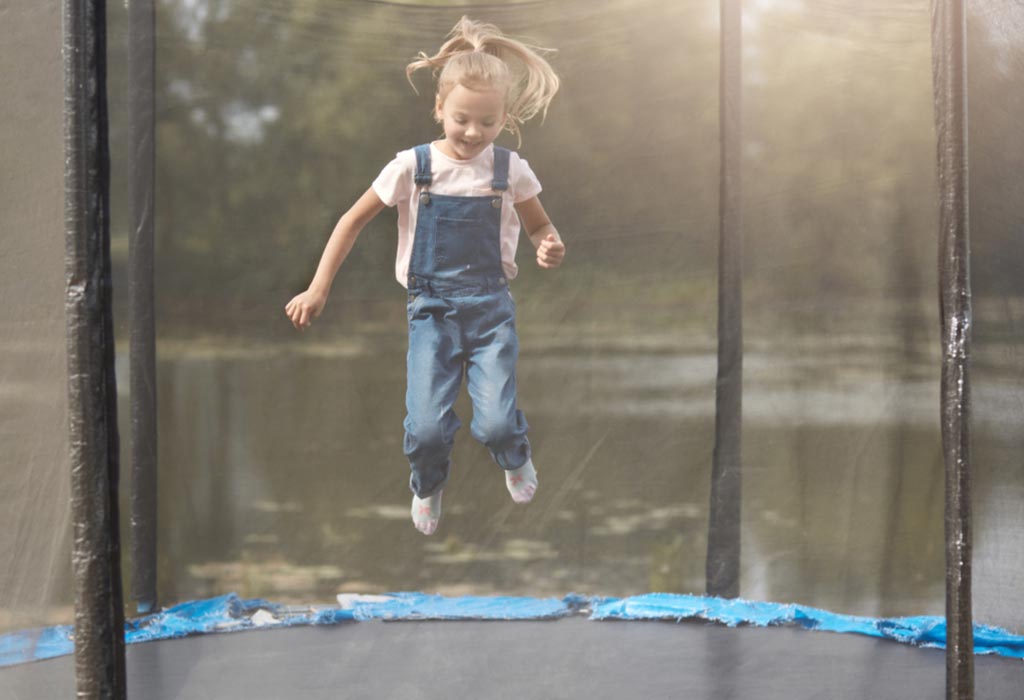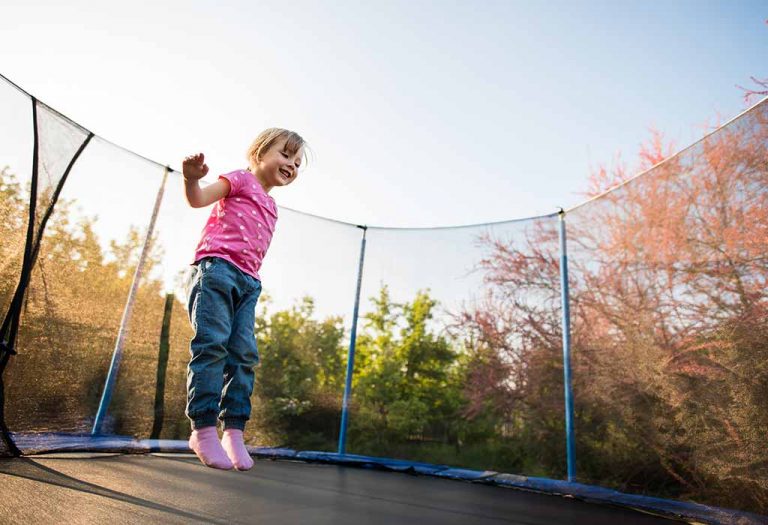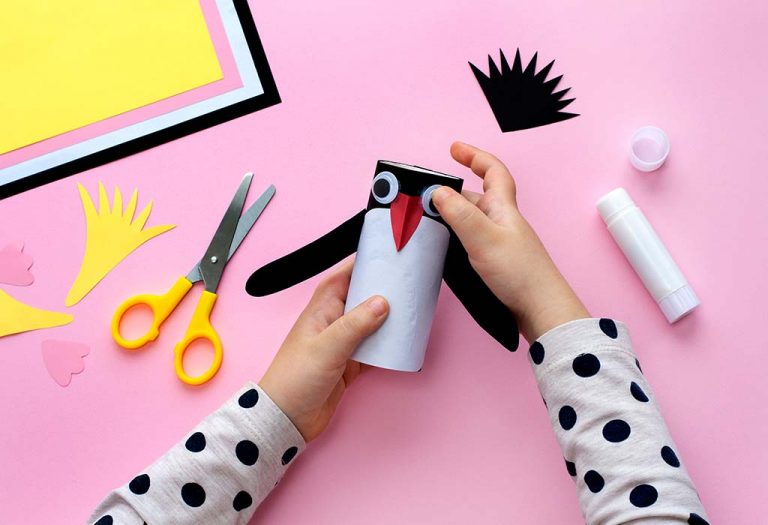Trampolining for Kids – Benefits and Risks
Trampolining is an energetic and fun activity enjoyed by all kids. The thrill of jumping on a trampoline gives kids a sense of adventure. This attracts kids of all ages to hop on a trampoline and squeal delightfully as they enjoy being airbound and falling back. Parents also want their kids to engage in such physical activity as it burns off their excess energy and helps keep them fit. For this reason, many trampolines are seen across homes and in playgrounds. However, before introducing your kid to a trampoline, you should know the benefits and risks of trampolining. So read on to understand how to make trampolining safe for your kids.
What Is a Trampoline?
A trampoline is one of the toys every child wants in childhood. Simply put, a trampoline is a fitness device that can also be used for recreational and gymnastic activities. It consists of thick mesh fabric stretched on a circular frame. The fabric is attached to the frame with springs, allowing a person to jump and bounce on top of it.
Right Age to Introduce Trampoline to Kids
Often, parents wonder what the right age is for them to introduce their kids to a trampoline. According to many studies, the right age for kids to start trampolining is six years. Before this, their bodies were not fully developed, and their bones were not strong enough to handle the repetitive pressure or impact of jumping. Young children under six may sustain injuries on the trampoline, so caution is advised. However, some studies say four-year-old kids who are active and well-built can do trampolining under adult supervision. For younger kids under four, their parents can let them play on a mini trampoline, provided all safety measures are taken care of.
Benefits of Trampolining for Children
Trampolining is not just kids jumping up and down on a trampoline. There is much more to it than jumping. Regular trampolining can provide many physical and mental benefits. Here is a list of trampolining benefits for kids.
1. Encourages Kids to Go Out
Trampoline encourages kids to go out and enjoy themselves instead of sitting inside and playing video games or playing on mobile phones. It ensures they get fresh air and the required amount of Vitamin D, keeping them healthy and active.
2. Improves Flexibility
When kids jump up and down on a trampoline, their muscles become lengthier, boosting their muscle strength and improving their flexibility.
3. Builds Immunity
Trampolining pushes toxins out of the body and boosts the absorption of nutrients as it stimulates the functioning of internal organs and promotes lymphatic circulation. So, bouncing on a trampoline detoxifies the body and strengthens the immune system.
4. Improves Posture
To maintain balance on a trampoline, the kid must constantly know their centre of gravity. Bouncing also requires stronger muscles. So, as kids learn trampolining, their muscles, spine, and joints become stronger. This increases their core strength and balance. As a result of these things combined, their posture improves.
5. Builds Physical Fitness
Trampolining improves physical fitness and makes exercise fun. As they bounce on the trampoline, the kids move their bodies and exercise without realising it. Some studies say ten minutes of bouncing on a trampoline equals thirty minutes of running. So, for kids and adults, a trampoline is a means of fun and play and is a good way of keeping fit and healthy.
6. Improves Coordination
A kid needs to control different limbs and muscles to maintain coordination and balance while jumping up and down on a trampoline. Combining bouncing, maintaining balance, and concentrating to adjust their position helps the kid improve their coordination.
7. Boosts Energy Level
As a kid bounces on a trampoline, more oxygen is inhaled and carried around in the bloodstream throughout the body. The increased oxygen instantly boosts energy levels and alerts the kid. So, to help your child become more active, get them on a trampoline.
8. Healthier Cardiovascular System
The kid’s heart rate increases when they jump on a trampoline. Increased heart rate strengthens the muscles for a healthier cardiovascular system.
9. Enhances Motor Skills
While trampolining, kids must use both sides of their bodies and brains. Bilateral brain function improves motor skills, dexterity, muscle control, and kinaesthetic awareness.

10. Makes Bones Stronger
Bouncing strengthens the child’s musculoskeletal system, increasing bone density. Also, since trampolining is done outside, the absorption of Vitamin D promotes healthy bone growth. So, trampolining strengthens kids’ bones and helps prevent serious bone issues such as osteoporosis.
11. Teaches Persistence
Mastering the trampoline takes time and effort. The kid needs to master coordination, concentration, and balance to move on the trampoline, which requires persistence. The persistence learned during trampolining is also used in other activities and spheres of life.
12. Develops Learning Ability
As the kid learns to control their body movement and balance on a trampoline, their learning ability for other things also improves. The concentration power of the kid improves, which in turn boosts their cognitive function.
13. Builds Confidence
Mastering the trampoline is no small feat. Their confidence and self-esteem improve when the kid learns to coordinate and balance on a trampoline. Bouncing on the trampoline also develops their physical fitness and makes them active physically and mentally. Together, all this boosts their self-confidence and courage.
14. Improves Their Mood
Jumping is a great mood enhancer for everyone. As the kid jumps on the trampoline, their oxygen circulation increases, which stimulates the production of endorphins. Endorphins are natural mood-enhancers, so more endorphins result in a better mood.
15. Protects Bones and Joints
Jumping on a trampoline is a low-impact activity, one of the main benefits of trampolines for toddlers. It is suitable for kids when their bones develop during their developmental years. Bouncing on a trampoline cushion protects their joints while making them stronger, unlike other high-impact exercises like jogging.
16. Improves Sleep Quality
Trampolining makes the kids go out in the sun and fresh air. This reduces their anxiety and stress and improves their sleep quality. Many of their sleep issues are reduced, helping kids sleep better and longer.
17. Helps With Studies
Trampolining improves the core strength of the child and helps them sit for a longer duration in school without disturbing their concentration. It also improves the child’s mental activeness and helps them stay alert and focused. So, trampolining improves the child’s memory and concentration, helping them study better.
How Does a Trampoline Help an Autistic Child?
Many studies state that trampolining is helpful for an autistic child. Many autistic kids struggle to interact with other kids or adults. These kids feel excluded from their peers in school and may find it challenging to make friends. With its various health benefits, trampolining gives autistic kids a great way to enjoy themselves and serves as a means to interact with other kids. It also helps in reducing anxiety and stress. Kids find the rhythmic action of bouncing soothing, especially after a stressful day or incident. So it allows the kid to stay calm and sleep well.
Trampolining improves impulse control, coordination, concentration, and focus, so it can have a positive impact on the behaviour of kids with autism. It is also a great means of providing sensory stimulation to help them focus on one activity. Thus, they learn to focus when they feel overstimulated.
Dangers of Trampolining for Kids
Trampolining can be a fun and energetic activity for children, providing physical exercise and entertainment. However, it also poses several risks that parents and guardians should be aware of to ensure the safety of their kids.
1. Risk of Fractures and Sprains
Children are at a high risk of sustaining fractures and sprains due to the high-impact nature of trampolining. Falls, awkward landings, and collisions can easily result in broken bones or sprained joints.
2. Head and Neck Injuries
One of the most severe risks associated with trampolining is head and neck injuries. These can occur from falling off the trampoline, landing improperly, or colliding with another person, potentially leading to concussions or even paralysis.
3. Spinal Cord Injuries
Improper use of trampolines can result in severe spinal cord injuries. These injuries are often the result of landing on the neck or back in an awkward manner, which can have long-term consequences and require extensive medical treatment.
4. Risk of Falling Off
Many trampolines lack proper safety enclosures, leading to a significant risk of children falling off. This can result in a variety of injuries, from minor scrapes to severe fractures or head injuries.
5. Impact With Hard Surfaces
Children can easily get hurt by landing on the trampoline’s frame or springs, typically made of hard, unforgiving materials. If these areas are not adequately covered or padded, they pose a significant danger.
6. Multiple Users and Collisions
When multiple children use the trampoline simultaneously, the risk of collision increases significantly. These collisions can lead to a variety of injuries, ranging from bruises and sprains to more severe conditions like concussions.
7. Overconfidence and Risky Behaviour
Children often become overconfident and attempt stunts or tricks beyond their skill level, significantly increasing the likelihood of accidents and injuries. This risky behaviour can lead to severe consequences, including long-term health issues.
How to Make Trampolining Safer for Children?
Trampolining is a fun activity for kids with many health benefits. However, to avoid mishaps, it is best to make trampolining safe for young kids. Here are a few tips to make trampolining safe for kids.
1. One Child at a Time Rule
Most common injuries happen on the trampoline when many kids jump together and collide with each other. So, the best way to avoid trampoline injuries is to allow only one kid at a time. You can have a time limit or turns when more than one child wants to play on a trampoline.
2. Purchase All Safety Equipment
To ensure your child’s safety, purchase a good-quality trampoline with all the proper safety equipment. Your trampoline should have shock-absorbing pads that completely cover the metal frame, hooks, and springs. It should also be covered with a net enclosure. Whenever you see any wear or tear in the padding, replace it immediately. Also, make sure to install the trampoline properly after reading the user manual.
3. Correct Location
The location of your trampoline must be chosen wisely. Set it up on level ground away from trees or other structures so that it stays stable.
4. Mandatory Adult Supervision
Kids will always be kids, so make sure one adult is always present when they are playing on the trampoline. The adult will ensure the kids are not flipping, hanging from the net, or colliding with each other.
5. Forbid Flips and Somersaults
Somersaulting and flips are dangerous, even for older kids. They put the kids at risk of head, spinal, or neck injury. So the adult present should forbid the children from doing these dangerous tricks.
6. Have a Separate Space for Other Kids Waiting
When there is more than one kid for trampolining, ensure a separate waiting space for the children waiting for their turn. If there is no separate space, the kids will end up standing near the trampoline, and the child bouncing on the trampoline may collide with them.
7. Provide Fun Challenges to the Kids
As somersaults and flips are banned from trampolining, try making it fun for the kids by devising exciting challenges or activities. You can ask them to throw a ball or play memory games while bouncing or waiting their turn.
Alternatives of Trampoline for Children
While trampolining can be an exciting activity for children, the associated risks may prompt parents to seek safer alternatives. Fortunately, numerous fun and engaging activities can provide similar physical benefits without the hazards of trampolining.
- Swimming Pools: Swimming provides excellent exercise and fun, with the added benefit of improving swimming skills and water safety.
- Playgrounds: Modern playgrounds with soft ground surfaces and safe equipment offer a wide range of physical activities, from climbing to sliding, that encourage active play.
- Dance Classes: Dance classes provide physical exercise and help children develop coordination, rhythm, and social skills in a structured setting.
- Martial Arts: Martial arts classes can improve children’s physical fitness, discipline, and self-defence skills while promoting respect and confidence.
FAQs
1. Are there any specific health conditions that make trampolining unsafe for children?
Children with certain health conditions, such as brittle bone disease (osteogenesis imperfecta), joint instability, or previous significant injuries, should avoid trampolining. It’s advisable to consult a paediatrician before allowing a child with any health condition to use a trampoline.
2. How often should safety checks be performed on a trampoline?
Safety checks on a trampoline should be performed frequently, ideally before each use. This includes inspecting the frame, springs, mat, and safety net for any signs of wear, tear, or damage. Ensuring that all parts are secure and functioning properly can significantly contribute to preventing accidents.
Trampolines are a great source of fun and enjoyment. Bouncing up and down on them is good for a child’s health and provides additional benefits such as improved concentration, motor skills, coordination, etc. However, using it safely is a must to get the best benefits of a trampoline.
Also Read:
Gymnastics for Children
Scavenger Hunt for Kids
How to Encourage Kids to Jump?
Jumping Games for Kindergartens
Engaging Outdoor Activities for Children
Was This Article Helpful?
Parenting is a huge responsibility, for you as a caregiver, but also for us as a parenting content platform. We understand that and take our responsibility of creating credible content seriously. FirstCry Parenting articles are written and published only after extensive research using factually sound references to deliver quality content that is accurate, validated by experts, and completely reliable. To understand how we go about creating content that is credible, read our editorial policy here.






















